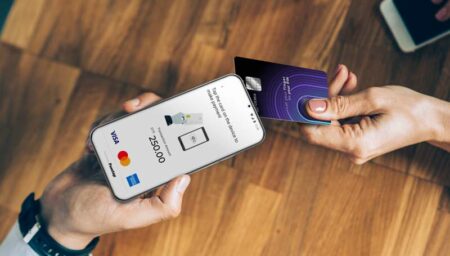Turning smartphones and tablets into contactless payment terminals

There is no doubt that the pandemic has significantly accelerated the digitalization of payments as consumers increasingly gravitate towards cashless transactions, especially by embracing the contactless experience. SoftPOS technology facilitates contactless payments by turning any smartphone into a payment terminal.
According to Mastercard, when compared to early 2020, the volume of contactless payments jumped by at least 50% in more than 100 countries1. Similarly, research commissioned by Visa noted that 65% of consumers globally would prefer to use contactless payments more widely than they do at present2.
Even countries such as Germany, Austria and Switzerland, which are strongly attached to using cash, have shifted towards cashless transactions—and more than three out of four of these payments are now contactless.
In truth though, contactless payments were already gaining traction long before the pandemic began. According to one piece of research, the global contactless payment market was worth US$1.168 billion in 2019 and was forecast to reach US$5.424 billion by 20273 – a compound annual growth rate of 20.6% from 2020 to 2027.
Contactless payments have also surged recently as regulators continue to remove the shackles by allowing consumers higher limits on contactless cards. In the UK, daily payment limits jumped from £35 to £100 in October 20214. This increase effectively covers average consumer daily expenditure, which further encourages the use of contactless cards.
Nevertheless, promising as this is, cashless and contactless technology isn’t without its challenges for merchants. These include technical issues, security considerations and logistical matters—not to mention the size and readiness of merchants to use these solutions and the demands of consumers in an “everything now” era and expectations of excellent customer experience.
Thankfully, Software Point-of-Sale (SoftPOS) technology – also known as Tap to Phone or Tap on Phone – can now meet the needs and expectations of both merchants and consumers in a secure and convenient way.
SoftPOS is software-based technology that can turn any mobile device – such as a smartphone or a tablet – into a contactless payment terminal, also known as “COTS,” or a “Commercial Off-The-Shelf” device.
SoftPOS is compatible with any near-field communication-enabled (NFC) Android device on which a merchant installs an application designed to accept contactless payments. Once the software has been downloaded, consumers can use contactless or digital payment cards to pay a merchant by simply tapping their card or their smartphone on a merchant’s SoftPOS-enabled mobile device.
This technology allows merchants to use their own devices to accept payments without having to buy dedicated, cumbersome and expensive hardware. This makes SoftPOS more effective than mPOS (Mobile POS) solutions, which require merchants to invest in dedicated hardware to accept contactless payments. This would include a dongle or payment terminal capable of reading the card chip or magnetic stripe.
Put simply, SoftPOS uses an established payment infrastructure, but with a more modern approach that leverages what has become our most treasured possession—our smartphone!
Because SoftPOS uses relatively affordable smartphones and tablets, the technology provides a more inclusive alternative to regular POS terminals, which are expensive and need to be maintained.
Small and micro businesses in emerging markets are cost conscious and significant investments will prevent them from being able to adopt contactless payments, and from passing on the benefits to their customers. Another big advantage is that merchants can use the same device for other useful applications, such as apps for ordering online.
In many emerging markets, small and micro businesses account for 40% of gross domestic product (GDP) but less than 10% currently accept cards or other non-cash or digital payments. This illustrates the tremendous potential for SoftPOS growth in these markets.
Besides financial inclusion, it is easy for merchants to activate and use their device with SoftPOS. Merchants need only to purchase a compatible device or use one they already have, download an app, conduct a know-your-customer procedure, provision the app and enroll with their merchant ID to connect to their bank account. These solutions can be deployed in a matter of minutes.
SoftPOS solutions are equally adapted to in-store payments in large department stores or small businesses such as a market stand or food truck. Large retailers can easily deploy SoftPOS solutions with limited investment that enables them to deal with peak in-store volumes more effectively. Merchants can even equip salespersons with smartphones/tablets to speed up payments and increase customer satisfaction.
Certain businesses rely on mobile sales forces, while others regularly participate in trade shows. Such businesses can use SoftPOS to equip their teams as they only need to carry a smartphone/tablet to process payments instead of cumbersome and expensive POS terminals.
SoftPOS is also suitable for delivery-based or service-based businesses such as plumbers or electricians. Using this technology they can accept and get instant confirmation of payments.
SoftPOS technology can be used to validate transport passes and tickets and to identify people trying to avoid paying their fare—eliminating the need for standalone ticket machines. It also enables commuters to use their payment cards instead of buying a physical ticket. Transit personnel can check that commuters have paid their fare by simply getting them to tap their payment cards on the agents’ smartphones.
The issuance of digital cards in smartphone wallets is already creating digital-first experiences for consumers, enabling them to use their means of payment instantly after onboarding. Similarly, SoftPOS technology has the potential to enable merchants to quickly begin accepting payments on their mobile devices, at minimum cost, and with minimum technical know-how—extending the digital-first experience to acceptance and acquiring space. This technology will help develop contactless payment by making it accessible to a large number of businesses, both big and small. It presents us with a glimpse of what the future of payments will look like: more accessible, more secure and more hygienic—enhancing both the consumer and the merchant experience.
1 https://www.mastercard.com/news/press/2021/april/mastercard-new-payments-index-consumer-appetite-for-digital-payments-takes-off/
2 https://www.visa.co.uk/about-visa/newsroom/press-releases.3088603.html
3 https://www.alliedmarketresearch.com/contactless-payments-market
4 https://www.theguardian.com/money/2021/aug/27/contactless-card-payment-limit-in-uk-to-rise-to-100-in-october